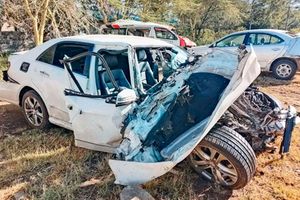Premium
Gachagua got it all wrong on Nairobi-Nanyuki railway line

UDA Deputy Presidential candidate Rigathi Gachagua during the debate at Catholic University of Eastern Africa on July 19, 2022.
What you need to know:
- What caught my attention was Gachagua's blatant lies, half-truths and misuse of words.
- Was the revival of the Nairobi-Nanyuki line for the exclusive use of one private firm or for personal use? Obviously not.
Most observers think Hon. Martha Karua was the clear winner of the deputy presidential debate earlier this week.
She was composed, poised and articulate.
Her competitor, Mr Rigathi Gachagua, looked furtive, often shaking his head from side to side, and seemed to refer to notes, which made him look unprepared and ill-informed.
But what caught my attention was his blatant lies, half-truths and misuse of words.
Was the revival of the Nairobi-Nanyuki line for the exclusive use of one private firm or for personal use? Obviously not.
Cement, livestock and fertiliser too are moved using the line!
Nanyuki is today a key distribution point for fuel. Originally developed by Vivo, the five-million-litre depot in Nanyuki is now a common-use facility.
Kenya Railways has revamped stations along the line and built a new one at Chaka in Kieni, Nyeri County.
New KPCU is rehabilitating its godowns in Sagana. The weekend passenger service is particularly popular and an inland container depot is coming up in Nanyuki.
State capture
Wikipedia defines state capture as “systemic political corruption in which private interests significantly influence a state's decision-making processes to their own advantage”.
Which private interests are served by Kenya Pipeline transporting fuel to Nanyuki by rail?
The same Wikipedia defines conflict of interest as “a situation in which a person is in a position to derive personal benefit from actions or decisions made in their official capacity”.
So how is the revival of the Nanyuki line a conflict of interest? The Nanyuki line makes perfect economic sense. Here is why.
The economy of the Mt Kenya region is estimated at 2.7 trillion.
Agriculture employs 2.7 million people while wholesale and retail trade employees top 690,000.
The gross value added per worker in agriculture is highest in Nakuru at Sh605,000 per worker per year, and lowest in Embu County at Sh104,000 per worker per year.
It is Sh151,000 in Kirinyaga, Sh154,000 in Murang’a and Sh246,000 in Laikipia.
Reason? Quite a bit of agricultural production in Nakuru is mechanised or technology-based.
Flower and vegetable farming around Naivasha is technology-intensive, compared to smallholder farming in Laikipia, Murang’a or Embu.
Micro and small feedlots
We can increase productivity through the use of machinery and other technologies.
In Laikipia, for example, we are promoting irrigated smallholder agriculture, as well as micro and small feedlots.
Alarmingly though, most basic tools and machines such as chaff cutters, grain dryers, pumps, basic irrigation equipment and so on are all imported.
Kenya imports on average Sh24 billion worth of machinery and capital equipment, mainly from China, India and UAE every single month!
What has this got to do with the railway? Plenty.
Besides agricultural inputs and products, we should use the line to move steel and steel products to facilitate the manufacturing of tools and machines.
Of course, moving fuel on rail is cheaper and safer. Clear, connected thinking. Not political slogans!
@NdirituMuriithi is the Governor of Laikipia County





